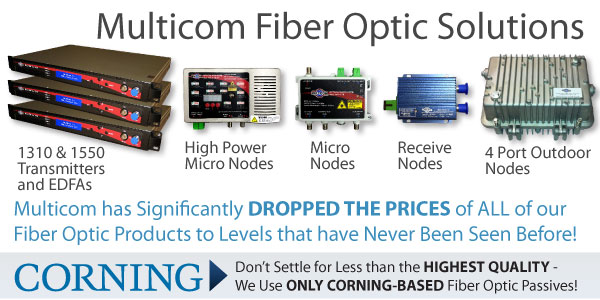When installing the network cable, which one do you prefer – copper cable or fiber optic cable? Let’s break it down and make it simple…
Today we Make our Case for Fiber Optics
Both copper and what is essentially glass, or fiber optics, have their advantages and unique characteristics. Copper has already existed in many places and it is cheap in network devices connection. However, with the dramatic reduction of cost of optical deployment, the future-proof fiber optic cable shows more advantages over copper and has a better prospect in the future market.
We are presenting five reasons for the choice in fiber rather than copper cable from cost, bandwidth, transmission speed and distance, durability and security.
1. CostA few years ago, the overall price of fiber cable was nearly twice that of copper, but now the price between fiber and copper has narrowed and fiber components and hardware have steadily decreased.
Let’s start with the general premise that electrical power transmission over copper is cheaper than laser power transmission over fiber – because it has been up until this point – though this is changing fast. Most people overlook the cost of the wiring closet in copper networks – and they shouldn’t. Let’s not forget, a standard wiring closet includes the costs of conditioned UPS (Uninterruptible Power Source) power, data ground, HAVC (Hybrid Automatic Voltage Control) and floor space.
These integral costs generally exceed the extra cost of fiber equipment in a centralized fiber architecture, as well as take up significantly more working space (which is often limited). So, an all-fiber LAN (Local Area Network) is really more economical and space-efficient than a copper-based networking environment for new construction and major renovations.
| Parameter | Fiber Optics | Copper |
| Bandwidth | 60 Tbps and beyond | 10 Gbps |
| Future-Proof | Evolving towards the desktop | CAT7 in development |
| Distance | 12 Miles+ @ 10,000Mbps | 300 Ft. @ 1,000Mbps |
| Noise | Immune | Susceptible to EM/RFI interference, crosstalk and voltage surges |
| Security | Nearly impossible to tap | Susceptible to tapping |
| Handling | Lightweight, thin diameter, strong pulling strength | Heavy, thicker diameter, strict pulling specifications |
| Lifecycle | 30-50 Years | 5 Years |
| Weight/1,000 ft. | 4 Lbs. | 39 Lbs. |
| Energy Consumed | 2W per User | >10W per User |
Although copper is perfectly adequate for a voice signal, it has very limited bandwidth – while fiber provides standardized performance up to 10 Gbps and beyond.
Fiber links provide over 1,000 times as much bandwidth as copper and can travel more than 100 times further as well. A typical bandwidth-distance product for multi-mode fiber is 500 MHz/km, so a 500 meter cable can transmit 1 GHz. While twisted pair optimized for high data rates (Cat 6) can transmit 500 MHz over only 100 meters. In addition, the signal loss over 500 meters in fiber is negligible, but copper has very high loss at high frequencies.
3. Transmission Speed and DistanceFiber optic versus copper transmission can be viewed as the speed of photons versus the speed of electrons. Photons travel at the speed of light, whereas electrons used in copper travels at less than one percent of the speed of light. Although fiber optic cables do not reach the speed of light, they are only about 31% slower. So you can see that there is a huge inherent speed difference between fiber and copper. In addition, fiber does not have the 100 meter distance limitation which is inherent in unshielded twisted pair copper without a booster. Therefore, distance can range from 550 meters for 10 Gbps multi-mode and up to 40 kilometers for single-mode cable.
4. ReliabilityFiber optic cable is much less susceptible to various environmental factors than copper cable. For example, copper will experience a great deal of degradation in quality over a distance of two kilometers, using fiber optic cable over the same distance can provide extremely reliable data transmission. What’s more, fiber is also immune to several environmental factors such as temperature and electro-magnetic fluctuations – copper cannot say the same – you can deploy fiber cable next to industrial equipment without worry. Also, like the transatlantic cable connecting the U.S. with Europe and beyond, fiber can be submerged in water.
5. SecuritySince optical fiber does not transmit electricity, it does not radiate signals and cannot be tapped – copper does use electricity and is susceptible to be tapped, which can cause the entire system to fail. A broken or damaged optical fiber can be detected extremely quickly by using a number of monitoring techniques including monitoring the actual power transmission or the transmission of a pilot signal. On the other hand, copper cable carrying a current can short-out completely or even cause a fire if it is damaged, old or worn without such efficient monitoring techniques.
Conclusion – and the winner is… ?The advent of optical cable with its ever-reducing cost, increased bandwidth, extremely high speed and long transmission distance, excellent reliability and perfect security, has replaced copper in every aspect of network transmission and reception. Fiber optic cable has become one of the most popular mediums for both innovative cabling installations and upgrades, including backbone, horizontal, and even desktop applications. And with the steadily lowering cost and intrinsic improvements made seeminly daily in fiber optic connectivity, fiber construction will become more convenient and cost-effective. It’s only a matter of time before fiber optics completely replaces copper cable in both long and short-haul networking.


